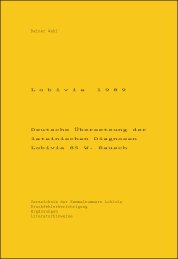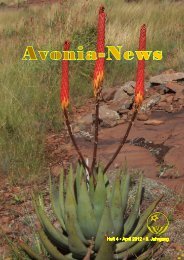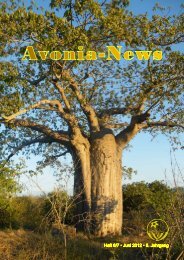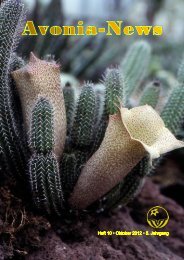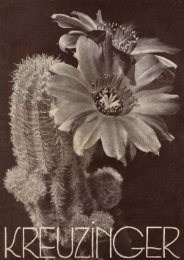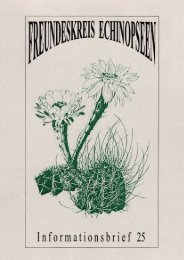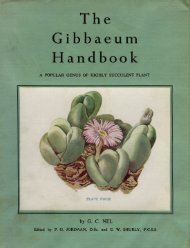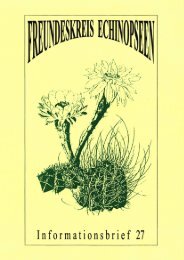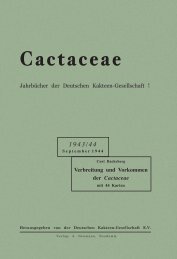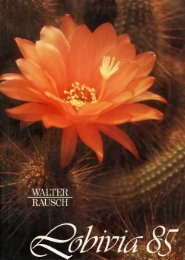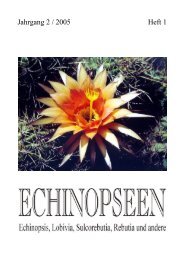VOLUME 14 :: January—October, 1952 Illustrations shown in ...
VOLUME 14 :: January—October, 1952 Illustrations shown in ...
VOLUME 14 :: January—October, 1952 Illustrations shown in ...
Create successful ePaper yourself
Turn your PDF publications into a flip-book with our unique Google optimized e-Paper software.
THE CACTUS AND SUCCULENT January, <strong>1952</strong><br />
THE SCIENTIFIC APPROACH TO SUCCULENTS<br />
By GORDON D. ROWLEY<br />
INSTALMENT FIVE<br />
Practical Experiments for the Amateur<br />
January is the month for plann<strong>in</strong>g the year's work <strong>in</strong> the glasshouse, and as good a time as any to take the plunge<br />
and prepare for some constructive experiment<strong>in</strong>g. Here, then, are details of just a few more obvious projects.<br />
1 Propagation problems<br />
F<strong>in</strong>d<strong>in</strong>g novel ways of multiply<strong>in</strong>g rare plants is a never-end<strong>in</strong>g source of amusement. I recall my own surprise<br />
and delight on receiv<strong>in</strong>g a robust Pelargonium ech<strong>in</strong>atum grown from a snippet of a flower stalk ; on rais<strong>in</strong>g Pereskias<br />
from leaves stuck <strong>in</strong> Vermiculite like Crassulas, and on watch<strong>in</strong>g discarded bulb scales from an old Bowiea sprout<br />
bulbils until I had so many I didn't know where to put them all. No less strange is the way that many promis<strong>in</strong>g<br />
leaves come to noth<strong>in</strong>g. Some may root, but fail to grow a shoot—a common experience <strong>in</strong> Haworthias, Kle<strong>in</strong>ias<br />
and Ficoidaceae. Would treatment with root<strong>in</strong>g hormones have the desired stimulat<strong>in</strong>g effect, I wonder ?<br />
Of particular <strong>in</strong>terest to the propagator are those curious succulents to which I have applied the name<br />
" caudiciform 1 ." These have <strong>in</strong> common a stout, fleshy, perennial trunk or " caudex," and slender, leafy, often<br />
short-lived branches. Owners of rare plants like Testud<strong>in</strong>aria, Idria, Fockea, Stephania, and the tuberous Adenias<br />
would earn our last<strong>in</strong>g gratitude if they could work out means of reproduc<strong>in</strong>g them from cutt<strong>in</strong>gs of roots or side<br />
branches. The case of the Medusa-head Euphorbias that require two steps before side branches can be <strong>in</strong>duced to<br />
form symmetrical heads has never been satisfactorily thrashed out, and bristles with possibilities for the keen<br />
experimenter.<br />
2 Grafts and Chimaeras<br />
Cutt<strong>in</strong>g fat plants <strong>in</strong>to pieces and stick<strong>in</strong>g them together aga<strong>in</strong> has a great appeal for many growers, and the<br />
suggestion that this may serve useful ends should set razors stropp<strong>in</strong>g all over England. What happens when<br />
a cactus is grafted upside down ? Do new shoots arise from its lower or upper end ? I cannot say : perhaps<br />
some enterpris<strong>in</strong>g reader will enlighten me. How does one species react to graft<strong>in</strong>g on different stocks ? In the<br />
world of fruit trees we recognise stocks which <strong>in</strong>fluence vigour and form of growth. Is it true that for best results<br />
the stock and scion should be genetically related—a Cereus on Cereus stock, Opuntia on Opuntia stock, and so on ?<br />
Also, why among succulents is graft<strong>in</strong>g almost the exclusive privilege of the Cactaceae ?<br />
Then there are <strong>in</strong> cultivation those very strange plants that we call chimaeras. A chimaera consists of two<br />
plants <strong>in</strong> one : a sk<strong>in</strong> of one over a core of the other. In this side by side weld<strong>in</strong>g of tissues, each layer preserves<br />
its identity, but character expression is dependent on a sort of <strong>in</strong>ternal tug-of-war between them. A break <strong>in</strong> the<br />
sk<strong>in</strong> exposes the core, and if a shoot arises here (as when plants are grown from root cutt<strong>in</strong>gs) it will be different<br />
<strong>in</strong> form and all of one tissue. Often this happens naturally, or shoots may appear composed of the surface tissue<br />
only : three different forms on one plant ! Variegated plants are often chimaeras and sort themselves out <strong>in</strong><br />
this way : the striped form of Aichryson domesticum, for <strong>in</strong>stance, always throws some branches that are wholly<br />
yellow. Sedum telephium variegatum when raised from root cutt<strong>in</strong>gs reverted to the orig<strong>in</strong>al green form : an<br />
example well worth follow<strong>in</strong>g up for variegated Sedums, Agaves, and any striped succulents. If root cutt<strong>in</strong>gs cannot<br />
be raised, try scoop<strong>in</strong>g out all the buds from the stem and forc<strong>in</strong>g new shoots to break out from the <strong>in</strong>terior.<br />
Chimaeras arise <strong>in</strong> nature by mutations, but can be synthesized by graft<strong>in</strong>g. If a number of grafts are cut<br />
back leav<strong>in</strong>g a th<strong>in</strong> film of scion cover<strong>in</strong>g the stock, a chance bud aris<strong>in</strong>g just at the po<strong>in</strong>t of union may conta<strong>in</strong><br />
a mixture of the elements of both species. Stem succulents should prove ideal subjects for chimaera production,<br />
be<strong>in</strong>g simple to graft and hav<strong>in</strong>g a large area of union. An excellent picture of a cactus chimaera is <strong>shown</strong> by<br />
J. J. V. Wolthuys <strong>in</strong> his book "The Enigma of the Orig<strong>in</strong> of Monstrosity and Cristation <strong>in</strong> Succulent Plants "<br />
Ed./2 (1948) 77, though the author's fanciful remarks about "vegetative splitt<strong>in</strong>g "of a hybrid are clearly <strong>in</strong>admissible<br />
<strong>in</strong> the light of the chromosome theory.<br />
3 Fasciations<br />
The occurrence of fasciations, nowhere more frequent or more startl<strong>in</strong>g than <strong>in</strong> some families of succulents,<br />
has long puzzled botanists, and it is evident that no one theory will account for the orig<strong>in</strong> of all such forms. Like<br />
callus-formation, fasciation is a reaction aga<strong>in</strong>st some irritant, whether that irritant is an external <strong>in</strong>jury, a<br />
nutritional upset, a pathogenic <strong>in</strong>fection, or a straightforward genetic factor. Sometimes it is <strong>in</strong>herited ; sometimes<br />
only the tendency to fasciate is passed on, need<strong>in</strong>g only some shock to start it off ; sometimes neither takes place.<br />
Undoubtedly more <strong>in</strong>formation is needed here, and any reader fortunate enough to have blooms on a crested plant



